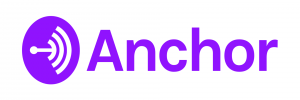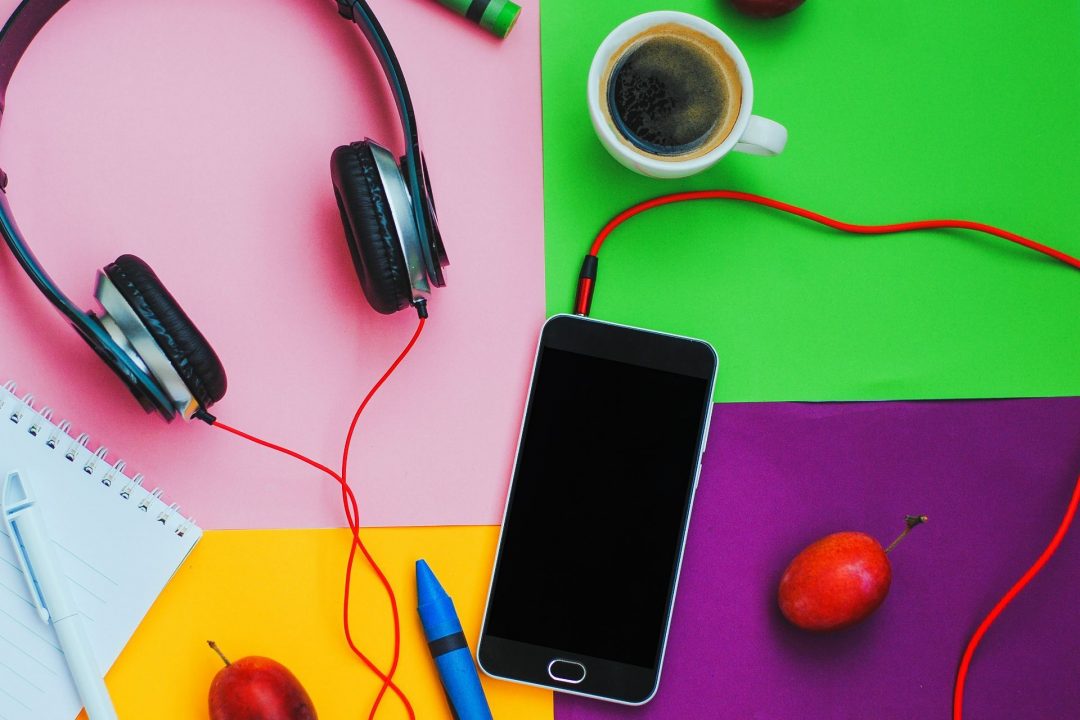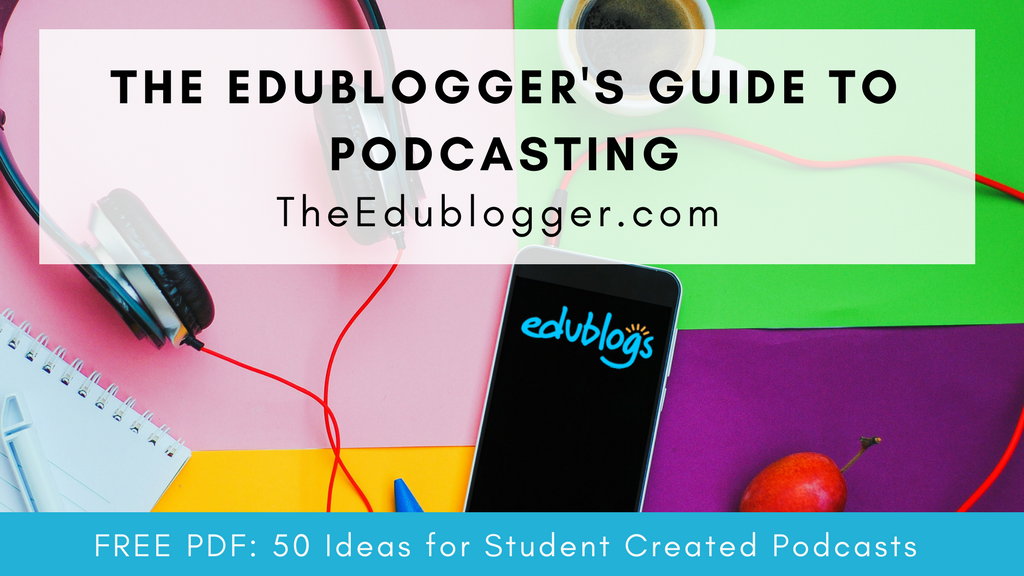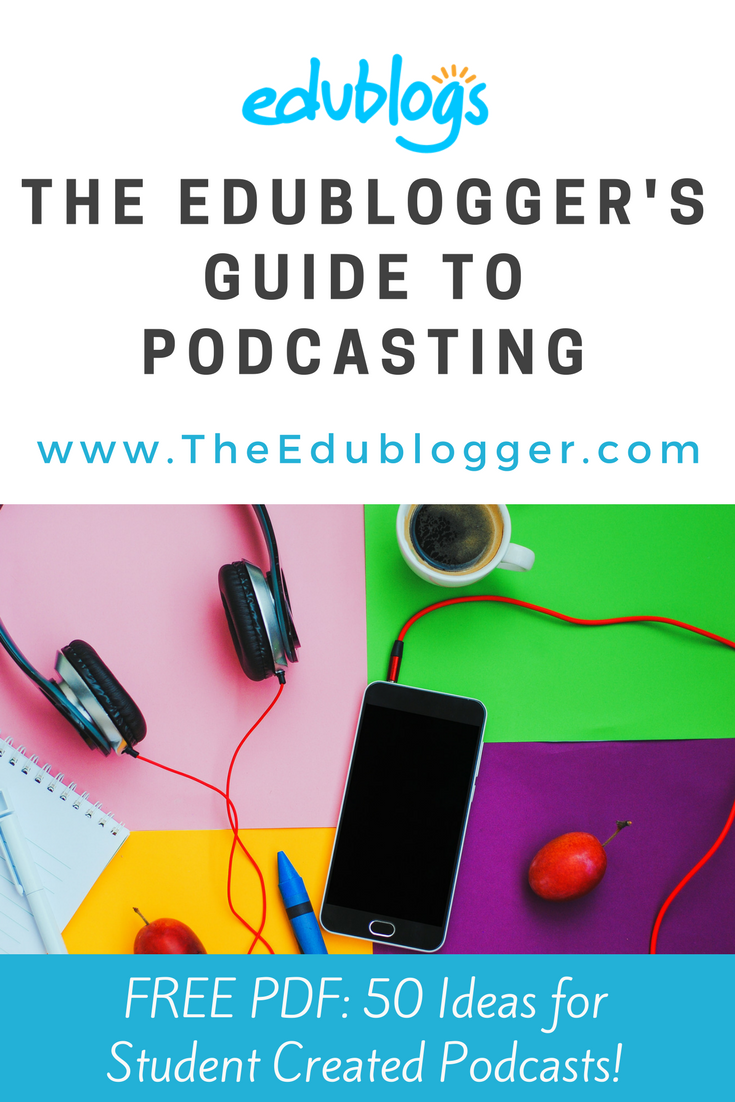Do you like podcasts? Chances are, either you or someone you know is a fan of listening to podcasts. According to a 2018 Nielsen study, not only is the number of people listening to podcasts growing rapidly, but the level of engagement is also increasing.
Podcasts and education go hand in hand!
This guide will help you understand what podcasts are, why they’re popular, and how to access or create your own podcasts. We’ve also included a PDF with 50 ideas for student created podcasts.
What are podcasts?
Podcasts are simply audio files that are published online. Podcasts can also include video or other sorts of file formats but for the purpose of this post, we’re talking about audio podcasts.
A podcast is similar to a radio show (or a television show that’s audio only). They often involve one person speaking on a topic, an interview, or a panel of presenters discussing a topic. Sometimes a podcast might be the audio recording of a lecture or video.
Podcasts are often set up as a season of regular episodes. For example, a new episode might be released each week, however, you can listen to it whenever it’s convenient for you. You can also go back and access archives of podcasts from previous weeks, months, or years.
Listeners can subscribe to their favorite podcasts to get notification of new episodes.
Here’s a great video from Common Craft that explains podcasts and podcasting in simple terms.
How do you access podcasts?
Podcasts have been around for well over a decade. Traditionally, podcasts were accessed more frequently via a computer. This has changed. According to the Nielsen study,
From 2014 to 2017, the podcasting audience on smartphones increased by 157%. The growth of podcasting is being driven by smartphones.
It used to be tedious to get podcasts from a computer to your device (I remember the frustration of syncing iPods!).
It’s now so easy to use the podcasting app on your phone or mobile device to browse, subscribe, download, and play podcasts.
If you use an Apple product, you can use the native podcast app (or there are others you can find in the App Store). Find out how to access podcasts if you use an Apple device.
If you use an Android device, there are a number of apps to choose from. Check out this Android Authority list of the 10 best podcasting apps for some ideas.
Many podcasters also share their episodes on a website, so you can play the podcast directly in your browser.
There are a few different ways to access podcasts but once you get the hang of it, you’ll find it’s really quick and easy. Share your favorite way to access podcasts in a comment.
Why are podcasts popular?
I’m a big fan of podcasts. The main reason I like podcasts is because you can consume content while doing something else— exercising, driving, cleaning the house etc.
Of course, there are definitely many things that can’t be multi-tasked while listening to a podcast– writing a blog post, for example! However, podcasts allow a lot more flexibility to learn or be entertained on-the-go than other sorts of media like video or written text.
Podcasts are also free! You don’t need to buy a book or sign up for a course to learn something new. With hundreds of thousands of podcasts available, there’s a good chance there’s a podcast on a topic you’re interested in.
There are many other reasons podcasts are popular such as:
- Flipped learning. For example, Andrew Douch has been creating biology podcasts for over a decade. Students consume or revise content outside of class freeing up class time for deeper work.
- Flexibility. You can listen at a time that suits you, pausing your episode and re-listening as needed. You can also speed up the podcast to consume it more quickly if that’s your style.
- Variety. Sometimes you might feel like diving into some deep learning on a topic, at other times you might be looking for some light entertainment. Whatever the case, there’s something to suit your mood! Some podcasts are only 5 minutes long, whereas others can go for hours meaning there are options to slot into your available time too.
- Ease. Advances in technology mean it’s easy to create a simple podcast (as I’ll explain later in the post) and it’s easy to access a podcast.
- Learning styles. Podcasts might not suit everyone but for those who are well suited to auditory learning or individuals who have reading or vision difficulties, podcasts may be a good option.
How can podcasts be used in education?
There are two main ways that podcasts can be used by teachers and students. They can be consumed or they can be created. Let’s take a look at both options.
Consuming podcasts
We’ve covered how to access podcasts so now you just need to browse or search for the episodes you want to listen to. In your podcasting app, just look for the search bar (or magnifying glass) and type in the title of the podcast you’re after, or keywords associated with the topic you’re interested in.
Some recommend podcasts
More and more individuals who work in education are creating their own podcast. There’s also a huge amount of podcasts on all sorts of topics that might interest teachers or students.
Here are some useful compilations of recommended podcasts for teachers or students
- Matt Miller has put together a summary of 20+ education podcasts.
- Eric Curts shares 12 podcasts to learn something new and 11 great edtech podcasts.
- Keri-Lee Beasley compiled a list of podcasts for primary school students and middle school students.
- Edutopia summarized the best education podcasts for 2017.
I often find that once you start listening to podcasts, you hear of others. This might be through a guest that appears on one of your ‘regular podcasts’, word of mouth, or general browsing (most podcast apps show you charts of the most popular podcasts).
Creating Podcasts
This is the fun part! It’s easier than ever to create a podcast.
You will need:
- either a phone, tablet, or computer
- an external microphone for better audio quality (or you can use the inbuilt mic)
- simple software or app for recording
- a blog to house your podcast if you wish
- an idea!
Examples of student created podcasts
Before your students start creating their own podcast, you might want to check out some examples.
- The Tiger Tales grade 5/6 students recorded their reader’s theatre performances as a podcast which they embedded on their blog.
- Ian Rockey who is head teacher at a UK primary school, assists his students to create a radio show which is also available as a podcast. This is a very professional production!
- Mrs. Vogel’s 6th grade students created podcasts on the world water crisis.
- Rob Kelly whose video creation tips have been featured on The Edublogger, also creates a weekly school podcast that complements their school television show.
- Aitken Creek Primary School uses a blog to publish short student created podcasts on a variety of topics.
- Russell Prue has been helping students and teachers in the UK create podcasts and radio shows for many years. His Soundcloud account shows many great examples of student created podcasts.
As you look at a variety of examples, you might notice there is a continuum when it comes to podcasting with students.
- At one end of the spectrum, students simply record straight into their computer or device, perhaps with only basic planning and rehearsal.
- At the other end of the continuum is a very polished production created with professional equipment. The podcast might include jingles, interviews, music, audience interaction and so on.
There’s no right or wrong way to podcast. The learning is in the process and you need to consider what would work for your circumstances (experience, time frame, equipment, goals, student age etc).
How to create a podcast
There are many ways to create a podcast. These steps demonstrate a simple workflow if you want to create a podcast and publish it on a blog.
- Script or outline what you’re going to say, remembering to include an introduction and conclusion.
- Find a quiet place to record if you can. Easier said than done in a school? You probably don’t have a recording studio available but recording in a room with carpet/soft furnishings/window coverings if possible will create better results.
- Record the podcast on some kind of software or app, for example, Voice Memos on iPad or iPhone. If you’re using a computer, Audacity is a popular choice for free software, as is GarageBand for Mac users. Remember, an external microphone will definitely offer better sound quality if you have the resources.
- Optional: Use your software like Audacity or Garageband to edit your podcast. Remove parts you don’t need and consider adding sound effects. Check out the list of places to find free music and sound effects from Richard Byrne and Larry Ferlazzo.
- If the audio file of your podcast isn’t too big, you can upload it straight to your blog post following these simple instructions.
- If you don’t have the space, or you’re wanting to create a series of podcasts, consider embedding your podcast. The first step is to upload your files to a free platform like Soundcloud or Podbean. These files can then be embedded on your blog by following these instructions.
Anchor.fm: A useful podcasting tool
Anchor.fm is an excellent free service for recording, hosting, and distributing podcasts.

You can create recordings on your computer or on the mobile app.
There are some great options for background music and you can even publish your Anchor recordings straight to iTunes, Spotify, Google Play etc. This could make it easy for your parents and students to keep up to date when they’re on-the-go.
Yet another excellent feature is that you can record a podcast with a guest or co-host in another city or country. All you both need is the app!
The only downside to this tool is that it is 13+ but teachers and older students could still use it.
Richard Byrne from Free Technology For Teachers has created a tutorial on how to create a podcast with Anchor.
Find the full post on Richard’s Practical Ed Tech blog.
Richard also created a short screencast to demonstrate how to embed an Anchor podcast into an Edublogs blog.
Note: If you don’t want to work with the text editor as demonstrated above, you can just click on Add Media > Insert Embed Code > Insert Into Post. If you need more help with embedding an HTML code, check out these instructions.
Another great feature of Anchor is the ability to create a transcript of your podcast. This could add a new element of learning to the podcast creation process and also assist those who aren’t auditory learners or who are learning English etc.
Check out this quick example I put together.
Note: As you can tell, sometimes it can be tricky to get the text to match the voice perfectly.
Also, you can’t embed an Anchor video with an HTML code. So you can either upload it to your blog (I uploaded mine using the ‘Embed Media Player‘ option). Or you can upload it to a service like YouTube or Vimeo first to get an HTML code.
In May 2018, Anchor announced a Mobile Importing Tool. This new range of features means students could make a theme song in GarageBand or turn voice memos into a podcast. Read more about Mobile Importing here.
Ideas For Student Created Podcasts
Like the idea of podcasting, but not sure what students could create podcasts about?
Richard Byrne has brainstormed ten ideas for classroom podcasts.
We’ve also put together 50 Ideas for Student Created Podcasts in a downloadable PDF below.
 Loading...
Loading...
We invite you to comment and let us know if you try any of these ideas. Or, share your own ideas for student podcasting!
Final Thoughts
If podcasting is something you haven’t explored before, we challenge you to give it a go.
Either download some podcasts and try listening to them next time you’re walking your dog or driving to work. Or, introduce your students to podcasting. You don’t need to be an expert. You can learn with your students. The outcomes might surprise you!
We’d love to hear from you if you have anything to add about podcasting. Scroll down to find the comment box.
What are your favorite podcasts? How do you access your podcasts?
Have you tried podcasting with students? Let us know how you went about it.
Other Posts You Might Enjoy
The Edublogger’s Guide To Global Collaboration



Hey, I’m Alba, student of Primary Education in the University of Murcia (Spain), for the course called “Resources and ICT” we had to make an activity related to making students record a podcast to show to their parts. Because of that, this post has been really useful in order to complete the task, besides, it’s really interesting in order to introduce ICT into the classroom, and develop new ways to innovate on the teaching field.
This is what I really need!
i like that
Love this resource!
What a great resource! A lot of front-loading goes into podcasts but once you get that ball rolling, wow, students will produce great work!
Thanks, Frank! You’re right. If you invest the time in getting the set up right, the results will no doubt be impressive!
Yes, the resource is great!
Can students post their podcasts here?
Hi Danielle,
Do you mean add a link in the comments? Sure thing! We’d love to see (or hear!) some student podcasts. 🙂
Thank you for this informative and inspiring article. I teach EdTech courses for Teacher Education undergraduate students & graduate students at Austin Peay State University in Tennessee. I would love to incorporate podcasts into a lesson. I think some students would be interested in creating their own podcasts. I will be bookmarking your article. Thank you!
Hi Joanna,
This is fabulous to hear! It’d be great for your undergrads and grad students to give podcasting a try. Maybe they’ll feel more comfortable being able to experiment before doing it with students. Good luck, Joanna!
Fantastic post, Kathleen, with all the needed info, well organised, and substantiated by recent research. Thanks for sharing,
Alexandra
Thanks, Alexandra. I hope a lot more people might realise that podcasting doesn’t have to be complicated. This was definitely a fun topic to research!
Ohh. Kathleen thanks your post. Nice written and nice every example. I shared your post.
Thanks for sharing it!
Thanks Kathleen.
I will check all the nice links and tips you provided in this interesting post and file!
Another superbly written post from Kath, highlighting the many benefits to podcasting and how easy it is to get into. Our children love their radio station and sharing their broadcasts with the world via their Soundcloud account, which is full of podcasts. It has really brought them an international audience and you are so right, people often listen whilst they are doing something else. For this reason I also started my headteacher’s podcast, kind of like a digital newsletter, which has proved very popular. Love the anchor.fm link, thanks Kath, I’ll be checking that out!
Thanks for your thoughtful comment, Ian. I know your collection of podcasts will be a real inspiration to people to see what’s possible! I like the way you have tried podcasting yourself too. It’s kind of like blogging. There are many advantages to having your own blog when your students are blogging.
I should mention that you’re @irockey on Twitter in case anyone reading this would like to connect with you.